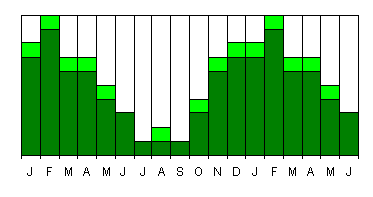
Home
Mission
Overview of Project
Project Staff
Sponsors
Achievements
Checking, Illustrations
Upcoming Activities
Id and Species Lists
Protea Information
Protea Gallery
Growing Proteas
Interim Dist. Maps
Publications
Afrikaanse Inligting
![]()
Timing of Flowering and Growth
Flowering
| Like animals, plants must make babies. Flowering plants have spectacular sex organs: flowers! (So be careful where you put your nose). The purpose of flowers is to con some poor bird or insect to carry the pollen from one flower to another so that the plants can make babies (fruit). Unlike animals, these babies - the fruit - can be stored (in cones, where they are safe from fire and some predators) or hidden (by conning ants or rats to bury them underground), or just discarded on the ground to survive there. |  |
Flowering has a cost. Flowerheads are expensive to produce (especially if the pollinators are large). And animals are not stupid: they need a reward to entice them to visit the flowerheads - nectar. Nectar is energy expensive and also water expensive. Birds need lots of water-rich nectar (about the same as tea with 2-5 spoons of sugar); insects a little, but more concentrated. Getting rodents to visit requires lots of nectar, but this can be syrupy and thus not water-expensive. Wind pollination does away with any rewards, but is expensive in terms of nitrogen and energy, in that large quantities of pollen must be made. And as wind does not conveniently move from one flowerhead to the next, most of the pollen is wasted.
Because flowerheads are water and energy expensive, they cannot be made in large quantities all year round. When should plants flower?
Also, there is no point in flowering and then forgetting to look after the fruit. Fruit stored on the plant must be protected, but the flowerhead may do, or be modified, for that. Fruit buried by ants needs to be released when ants are active. Fruit buried by rats needs to be dropped "en masse" so that the rats will be swamped and store the excess (where hopefully they will forget about some: the squirrel strategy) - If the fruit were to be released slowly the rats could eat them all! Another important thing is that the time between making the fruit and the greatest chance of fire must be as short as possible (not too short, they must be ripe BEFORE the fires come). When should plants make their fruit?
Some plants use birds, and even mammals, to disperse the fruit - by providing a reward - a fleshy bit as the reward. Mammal and bird dispersal is ideal where fruit should be placed in a particular place (e.g. on a tree trunk for a parasitic plant or strangler fig), or where special places are needed to help the seeds to germinate and grow.
No proteas use birds for dispersal! Why not? (clue: What ecological process levels the playing field and gives every seed and seedling an equal chance to get going?).
See if you can answer some of these questions from the information displayed below. The graphs show the state of flowering for each month from January through January to June - a period of 18 months.
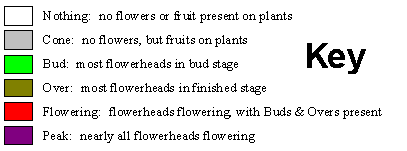
Common Sunshine Conebush: Leucadendron salignum (Knoppiesgeelbos): Note the strong winter Flowering & high background level of Cones. Flowering lasts for 7 months and there is very little flowering activity between November and April. But these patterns are because this species is widespread (this is the most widespread protea), and at any place flowering seldom lasts more than a few weeks. This species is insect pollinated (small beetles). It is a resprouter after fire (i.e. it survives fires as underground stems, from which it resprouts after the above ground parts are killed by fire). It stores the fruit on the bush in hard fire-proof cones, which only open to release the fruit after the fire.
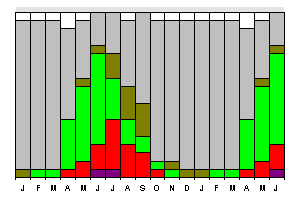
Golden Sunshinebush Leucadendron laureolum (Louriertolbos): This is also a winter flowering species, but note that almost all the Flowering occurs in a burst during July, although some Flowering does occur over 5 month period. There are no Buds after the Flowering period, and no Overs before Flowering. There is very little activity between September and March. This species is insect pollinated (small beetles), and occurs on sands flats and mountains from the Cape Peninsula to De Hoop Nature Reserve. It is killed by fire, and survives by storing its fruit in fire-proof cones (note the Cones for most of the year). The fruit are released from the dead skeletons after a fire.
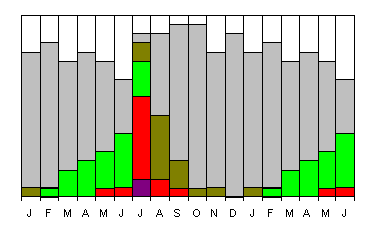
Common Stream Conebush Leucadendron salicifolium (Riviertolbos): This species has the same habits as Ld laureolum: it is killed by fire & it stores its seeds in fire-proof cones. But it is pollinated by wind. Note the similarities and differences in Flowering between the two species: a longer, less peaked Flowering period (lasting 4 months), more often in Peak flower. There is very little Flowering activity between October and June.
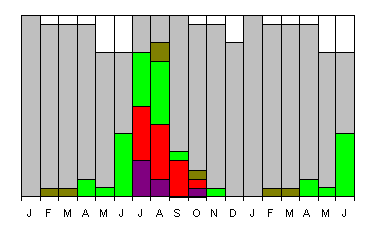
The Pincushion Ls cordifolium (Bobbejaanklou): Note the strong summer Flowering (September to February - 7 months, with lots of flowerheads), the long period of Buds, and short periods for Over & Cone. The fruit are stored underground (they are carried there by ants - which are most active in January-February), where they are safe from fire. The plants are killed by fire. Pollination is by birds (primarily the Cape Sugarbird and Orangebreasted Sunbird, but also Malachite Sunbirds).
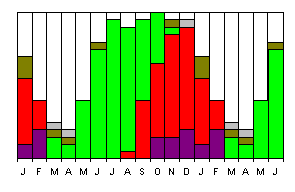
King Sugarbush Protea cynaroides (Koningsuikerbos): Note that there are no trends. There is a near constant of 50% for combined Cones and Nothings. This species resprouts after fire. Although it stores its fruit in fire-proof seedheads, these seedheads are not as long-lived as in other proteas. Also many plants do not flower every year. This is a widespread species (compare with Ld salignum), and local populations do show some weak seasonal peaks (winter in Western Cape, summer in Eastern Cape). Note the lack of any Peak flowering, and that both Buds and Overs are always present.
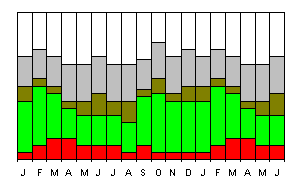
Claspingleaf Sugarbush Pr amplexicaulis (Bloekomblaarsuikerbos): This is a fairly widespread species. It is pollinated by rats. Note the spring Flowering period which lasts for 4 months - more or less the same time as the rats are having their babies. It is in Bud for most of the year, with only a very short rest period (1 month - November). Fruit are stored in fire-proof fruitheads, but these are not very long-lived. The plants are killed by fire. Unlike all other Sugarbushes, this species has its flowerheads at the base of the bush: this is handy for the rodents, but it also means that branch growth is not bothered by having the flowerheads at the tips.
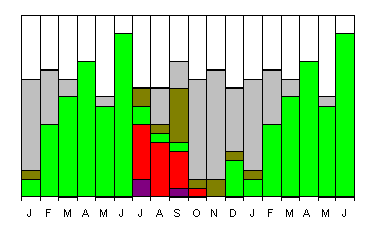
Greyleaf Sugarbush Pr laurifolia (Louriersuikerbos): This is a tree-like Sugarbush of the Western Cape. It is pollinated by birds (mainly the Cape Sugarbird and Orangebreasted Sunbird) and beetles (many different types - several thousand of several species may live in a single flowerhead), and many other insects visit the flowerheads (not only to drink nectar, but also to eat those living inside). Note the long winter Flowering period (8 months), which runs straight into the start of Buds. The high level of Cones shows that this species stores the fruit in fire-proof seedheads, and the fruit are only released after the fire has killed the plants. However, being so big (compared to the heaths and reeds) the fires often sweep around the trees without killing them, although smaller plants are almost always killed.
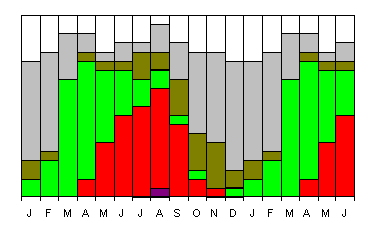
Why do some species flower for so long, whereas others flower for such short periods?
Which species flower to suit their pollinators, and which to suit their seed dispersers?
Which of the above proteas do you think is most cunning about choosing its time to flower?
Growth
Just like plants cannot just flower willie nilly, they cannot just grow all the time.
| Growing needs water. Protea leaves are soft and tender when young, and need to be "pumped up" to full size before they can be hardened - this needs lots of water. Also, when the leaves are tender they can easily be eaten. That is why many proteas have hairy baby leaves - these clog up insect mouthparts. Also the baby leaves can overheat: water can cool them, and a red colour may help them to dump heat. Once the protea leaves are big and hardened then they can cope with the adult world: insects cannot eat them (not enough protein), too-little water won't harm them (the tough woody skeleton will protect them from collapse) and they can have shiny, waxy or hairy surfaces to help them stop losing too much water. |  |
Also, the baby leaves need lots of protein, chlorophyll and other compounds. This means that they must be made when the plants are most active (unless these compounds can be stored in the meantime). It also means that growing cannot always occur at the same time as flowering (unless the compounds are stored, or unless growing is done slowly). The time of most "activity" is during the hottest time of the year, but only if the plants still have water. Fortunately, proteas have deep roots and can continue being active well into the dry summers, long after other plants have shut up shop.
There is a structural problem too. Most proteas have their flowerheads at the branch tips. This means that once the flowerheads are made, the branches stop. New branches must form underneath the flowerheads (in the leaf axils) and start growing.
When then should plants grow? Will flowering affect the timing of new growth?
The Pincushions have nectar glands at the tips of the new leaves. These may help them to expand, but probably attract wasps and ants to eat up any hungry caterpillars. Conebushes tend to have black "mucro" tips which may do the same thing. Sugarbushes have hard rims with glossy glands at the leaf tip. We don't really know why these leaves have these structures!

Common Sunshine Conebush: Leucadendron salignum (Knoppiesgeelbos): Note the February-March Peak, with the low growth corresponding to the flowering period. There is a little rest period from everything (both growth and flowering) in November (perhaps a time to grow roots?). Like flowering, growth is symmetrical - it starts and finishes in a similar pattern.
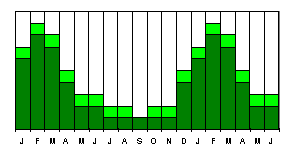
The Pincushion Ls cordifolium (Bobbejaanklou): Note the December-February Peak, with a distinct gap in winter, which is when there are lots of Buds. Also growth, like flowering is asymmetrical - but flowering starts slowly and suddenly stops, while growth starts slowly, suddenly peaks (as flowering drops) and then gently slows down.
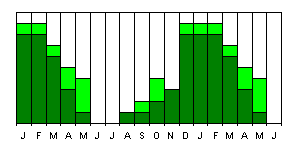
King Sugarbush Protea cynaroides (Koningsuikerbos): Note the low November Peak (only 80% of the plants are growing, and only 60% are growing vigorously ). But then there is always a low level of new growth. This matches the flowering pattern with growth during the period when Flowering "drops" to 5%.
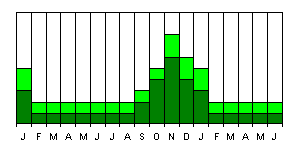
Golden Sunshinebush Leucadendron laureolum (Louriertolbos): Note the long period of growth, lasting from November to June, with a peak in January. The quiet period is when the plants are flowering, but there is a rest period from August to October when the plants are not growing or flowering. What might they be doing? In some places the plants may be waterlogged in late winter (they like deep sands on the flats).
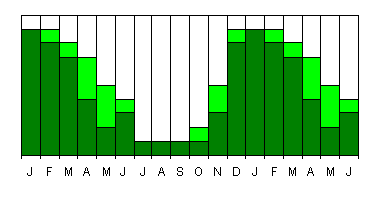
Greyleaf Sugarbush Pr laurifolia (Louriersuikerbos): Note the long growth period, lasting from September to February with a peak during November-December. Relatively little growing is done between March and August - the period of most flowering! Unlike Ld laureolum, there is no rest period!
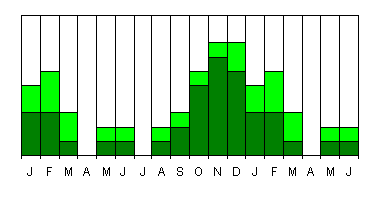
Claspingleaf Sugarbush Pr amplexicaulis (Bloekomblaarsuikerbos): Here we have a species which grows all year round. Only during July and August (the peak flowering months!) is growth markedly low! The rest of the time most of the plants are growing. Could this be because the flowerheads (at the base of the plant) do not structurally interfere with growth?
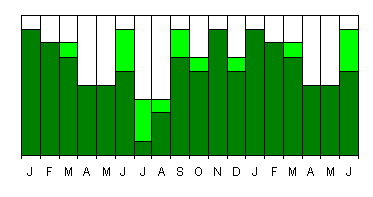
Common Stream Conebush Leucadendron salicifolium (Riviertolbos): High levels of growth are maintained for most of the year (8 months) , except for June to September, when there is a marked dip. Since the plants flower from June to August, September is again a rest period.
